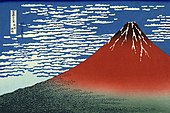Ancient Chinese engraving of female instrumentalists
Printmaking is creating, for artistic purposes, an image on a
matrix
that is then transferred to a two-dimensional (flat) surface by means
of ink (or another form of pigmentation). Except in the case of a
monotype, the same matrix can be used to produce many examples of the print.
Historically, the major techniques (also called media) involved are
woodcut,
line engraving,
etching,
lithography,
and screenprinting (serigraphy, silkscreening) but there are many
others, including modern digital techniques. Normally, the print is
printed on
paper, but other mediums range from cloth and
vellum to more modern materials. Major printmaking traditions include that of Japan (
ukiyo-e).
European history
Prints in the Western tradition produced before about 1830 are known as
old master prints. In Europe, from around 1400 AD
woodcut, was used for master prints on paper by using printing techniques developed in the Byzantine and Islamic worlds.
Michael Wolgemut improved German woodcut from about 1475, and
Erhard Reuwich, a Dutchman, was the first to use cross-hatching. At the end of the century
Albrecht Dürer brought the Western woodcut to a stage that has never been surpassed, increasing the status of the single-leaf woodcut.
[14]
Chinese origin and practice
In China, the art of printmaking developed some 1,100 years ago as
illustrations alongside text cut in woodblocks for printing on paper.
Initially images were mainly religious but in the
Song Dynasty, artists began to cut landscapes. During the
Ming (1368–1644) and
Qing (1616–1911) dynasties, the technique was perfected for both religious and artistic engravings.
[15][16]
Development In Japan 1603–1867
Woodblock printing in Japan (Japanese: 木版画, moku hanga) is a
technique best known for its use in the ukiyo-e artistic genre; however,
it was also used very widely for printing books in the same period.
Woodblock printing had been used in China for centuries to print books,
long before the advent of movable type, but was only widely adopted in
Japan surprisingly late, during the Edo period (1603–1867). Although
similar to woodcut in western printmaking in some regards, moku hanga
differs greatly in that water-based inks are used (as opposed to western
woodcut, which uses oil-based inks), allowing for a wide range of vivid
color, glazes and color transparency.





